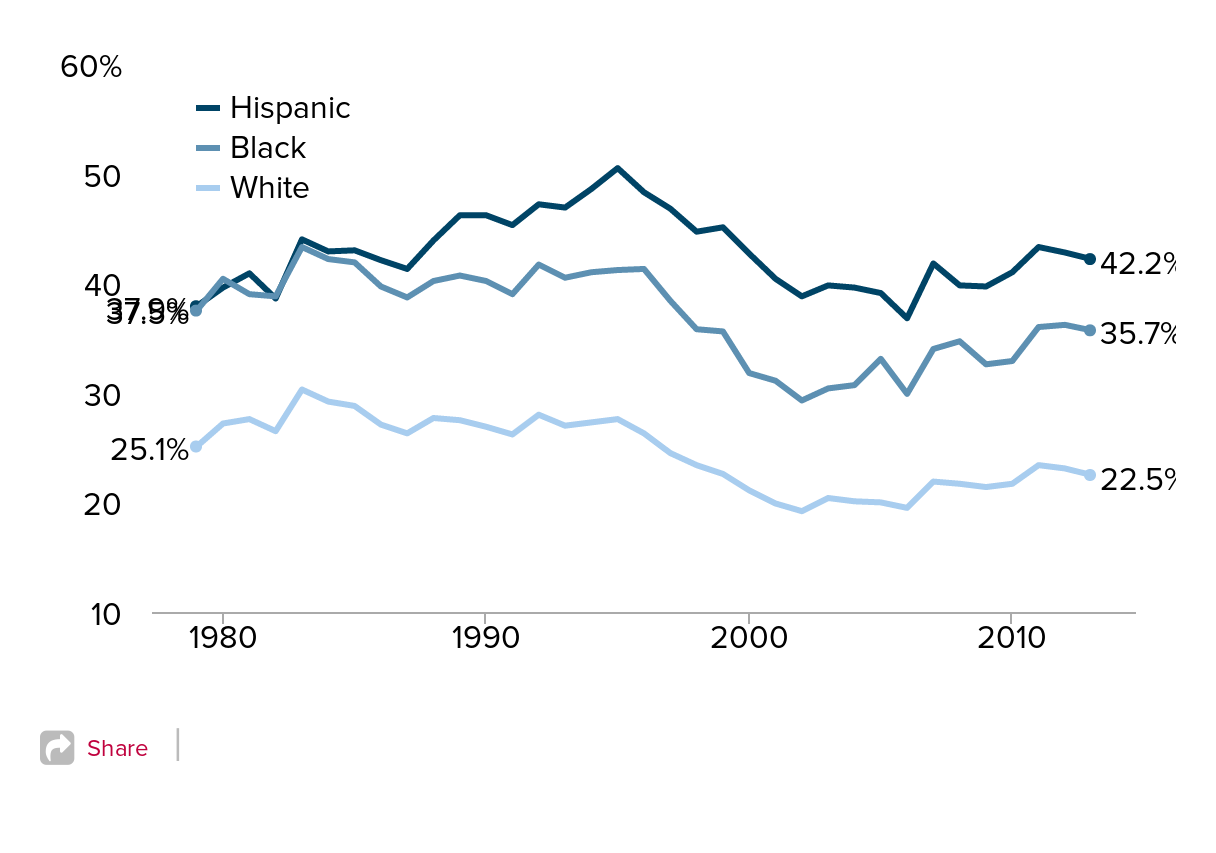The figure below shows the share of Hispanic, black, and white workers that earn hourly wages that would be insufficient to bring a family of four above the poverty threshold even for full-time, full-year workers. A substantial share of working people earn less than these poverty-level wages—for African Americans and Hispanics, these percentages are astounding. In 2013, 42.2 percent of Hispanic workers and 35.7 percent of black workers, compared with less than one-fourth (22.5 percent) of white workers, earned poverty-level wages.
Hispanic and black workers are most likely to earn poverty-level wages: Share of workers earning poverty-level wages, by race and ethnicity, 1979–2013
| Year | White | Black | Hispanic |
|---|---|---|---|
| 1979 | 25.1% | 37.5% | 37.9% |
| 1980 | 27.2% | 40.4% | 39.6% |
| 1981 | 27.6% | 39.0% | 40.9% |
| 1982 | 26.5% | 38.8% | 38.6% |
| 1983 | 30.3% | 43.3% | 44.0% |
| 1984 | 29.2% | 42.2% | 42.9% |
| 1985 | 28.8% | 41.9% | 43.0% |
| 1986 | 27.1% | 39.7% | 42.1% |
| 1987 | 26.3% | 38.7% | 41.3% |
| 1988 | 27.7% | 40.2% | 43.9% |
| 1989 | 27.5% | 40.7% | 46.2% |
| 1990 | 26.9% | 40.2% | 46.2% |
| 1991 | 26.2% | 39.0% | 45.3% |
| 1992 | 28.0% | 41.7% | 47.2% |
| 1993 | 27.0% | 40.5% | 46.9% |
| 1994 | 27.3% | 41.0% | 48.6% |
| 1995 | 27.6% | 41.2% | 50.5% |
| 1996 | 26.3% | 41.3% | 48.3% |
| 1997 | 24.5% | 38.4% | 46.8% |
| 1998 | 23.4% | 35.8% | 44.7% |
| 1999 | 22.6% | 35.6% | 45.1% |
| 2000 | 21.1% | 31.8% | 42.7% |
| 2001 | 19.9% | 31.1% | 40.4% |
| 2002 | 19.2% | 29.3% | 38.8% |
| 2003 | 20.4% | 30.4% | 39.8% |
| 2004 | 20.1% | 30.7% | 39.6% |
| 2005 | 20.0% | 33.1% | 39.1% |
| 2006 | 19.5% | 29.9% | 36.8% |
| 2007 | 21.9% | 34.0% | 41.8% |
| 2008 | 21.7% | 34.7% | 39.8% |
| 2009 | 21.4% | 32.6% | 39.7% |
| 2010 | 21.7% | 32.9% | 41.0% |
| 2011 | 23.4% | 36.0% | 43.3% |
| 2012 | 23.1% | 36.2% | 42.8% |
| 2013 | 22.5% | 35.7% | 42.2% |

Note: Race/ethnicity categories are mutually exclusive (i.e., white non-Hispanic, black non-Hispanic, and Hispanic any race). The poverty-level wage in 2013 was $11.45.
Source: Authors' analysis of Current Population Survey Outgoing Rotation Group microdata
UPDATED FROM: Figure 4F in The State of Working America, 12th Edition, an Economic Policy Institute book published by Cornell University Press in 2012
The figure also shows a sharp decline in the share of workers earning below poverty-level wages during the late 1990s, a period that was consistent with low unemployment and rapid wage growth—the only time wages have consistently risen in the past three-and-a-half decades. It goes without saying that poverty is linked to how much one earns from working, which is why wage stagnation is a leading challenge in the fight to reduce poverty. Since 2002, wage growth has been stalled and the share of workers earning poverty-level wages has been increasing. The number of African American workers falling into this category has grown the most over this period—an increase of 6.4 percentage points.
There’s a misconception in America that poverty is the result of cultural pathologies, a deficient work ethic, or laziness on the part of those who are poor. And since poverty rates are higher among people of color, it’s sometimes erroneously assumed that these groups are disproportionately lazy or unwilling to work hard. In fact, nearly 70 percent of the income of Americans in the bottom fifth is tied to work, either in the form of wages, employer-provided benefits, or tax credits that are dependent on work (such as the Earned Income Tax Credit). In short, the bottom fifth of American households are deeply connected to the labor market, and its failures become their problem.
This link between income and work also means that persistent racial wage gaps contribute to disparate poverty rates—broad-based wage growth is essential not only for fighting poverty but also narrowing racial wage gaps.
This Economic Snapshot is part of EPI’s new project Raising America’s Pay, a research and public education initiative that seeks to make wage growth an urgent national priority. Over the next three years, Raising America’s Pay will highlight our failure to provide broad-based wage growth, research and explain the role of labor market policies and practices in depressing wage growth, and identify policies that will boost wages for the broad-middle class.